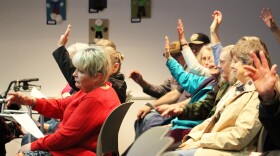In a borough the size of Massachusetts and New Jersey combined, it can be tough to get around without a car. That’s why a discussion this week in Kenai brought people together to talk about the gaps in public transportation in the Kenai Peninsula Borough, and how to fill those gaps.
On Thursday at the Challenger Learning Center in Kenai, dozens of representatives from community organizations came together to talk about what the Kenai Peninsula’s transportation needs.
Anchorage-based consultant Denali Daniels facilitated the meeting, and Borough Mayor Peter Micchiche started off the day with a welcome message that called on the peninsula to “grow up” and fix its transportation gaps.
Then, the event kicked off with a presentation from Cassidi Cameron with the Kenai Peninsula Economic Development District, or KPEDD. Cameron reviewed KPEDD’s recent transportation survey, which launched last winter to gather information about regional transportation needs.
The survey results reveal that the community’s desire for improved public transportation is strong — more than 75% of respondents said they believe there is community support for a transportation service. Other results show the desired uses of public transit would be for shopping, and getting to work and medical appointments.
Written responses to the survey show strong dissatisfaction with CARTS, the current public transit option for the central peninsula, which requires 24-hour scheduling notice.
Then the group heard a presentation from Darrell Williams with the Ninilchik Tribe, who talked about BUMPS, the tribe-run bus that goes between Soldotna and Homer three days a week. Williams said making the bus happen was a struggle, and maintaining it has been costly, but now the tribe is ready to grow the program.
Other presenters included Brent Hibbert with Alaska Cab, Eric Taylor from the Alaska Department of Transportation, and Chelsea Hendricks and Brandi Bell with the Kenaitze Indian Tribe, who talked about the tribe’s forthcoming bus program Kahtnu Area Transit, which will provide service between Sterling and Nikiski by the end of the year. That transit system will serve the whole community, not just tribal members.
In the afternoon, the attendees transitioned to discussing problems and solutions. Groups worked in tables to pick out the biggest issues facing transportation in the borough.
“We identified some of our gaps that we see as how we’re going to serve individuals with mobility needs. We talked about students after school, after-school jobs, after-school activities. Employment, the biggest one, most likely,” Bell, with Kenaitze, said, listing off gaps her group identified. “Getting to and from college. Finding our funding gaps.”
Joyanna Geisler presented for her table.
“There is no successful model on the peninsula that works and could be replicated or duplicated. There is a lack of public input from riders. There is little, if any, financial contribution from the various cities and borough at this point,” she said.
Other reported gaps included a lack of grant writers, transportation to outlying areas, a lack of funding and equipment, no consolidated agency and too little communication between different transportation providers.
Then, the group pivoted to discussing next steps. Popular ideas included a central dispatch, a brough transportation committee, and hiring a coordinator.
In some closing thoughts, Tim Navarre, director of the Kenai Peninsula Foundation — a sponsor of the meeting — said the most important thing to do going forward is keep the momentum.
“The biggest thing we have to not do is drop the ball. Not that we’ve ever really dropped the ball, because it’s always been there, but sometimes we don’t bounce it as high as we should have or get involved,” he said.
Navarre said another meeting is in the works for early June, as well as one in September.








